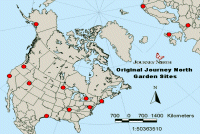Tulip Garden Update: September 12, 2003
Today's Report Includes:
- Follow the Wave of Spring
- Two Stand Alone
- Look Closely Before Planting
- Teacher Tip: Organizing the Tulip Project
- Thanks to Our Original Gardeners!
- Challenge Question #1
- Seasons and Cycles: Plants as Metaphors for Growth and Change
- Classroom Experiments Wanted
- Challenge Question #2
- Going to Extremes: The Annual Microclimate Challenge
- Challenge Question #3
- How to Report to Journey North
Follow the Wave of Spring
It's Time to Dig In! This fall, plant a Journey North Tulip Garden so you can proclaim the official arrival of spring in your community.
By sharing observations over the Internet, students across North America will follow the wave of spring as it moves northward and measure its pace from distant places.

Two Stand Alone
The first 2 gardens of 2003 have been planted! Early birds from Lexington, KT and Gallatin, MO got a jump start on the season. How is your garden planning going?
- Link to
Tulips Planted
Look Closely Before Planting
But before you take your last look, maybe there are some important things you should know about them:
- Are all the bulbs in the class alike?
- How might their differences affect their growth rates?
- What do bulbs look like inside?
- Where will next spring's leaves and flowers come from?
Your bulbs are the tools you're trusting to gauge spring's arrival. So get to know them before planting.
Teacher Tip: Organizing the Tulip Project
Each year that Journey North is presented we welco me many first-time teachers and classrooms. In an effort to make managing our projects easier for all participants and especially new ones, we have asked some of our “seasoned” teachers for tips. Here’s a tip to help you get organized:
Find more helpful tips here:
Thanks to Our Original Gardeners!
 |
Study each school's location information:
Then try this:
Challenge Question #1
"In what order do you think the 13 Official gardens will bloom next spring? List the 13 sites in order, from 1st to last."
(To respond to this question, please follow the instructions below.)
Seasons and Cycles: Plants as Metaphors for Growth and Change
Planting a garden is a new and exciting experience each year. You get to be outside and dig in the soil. You take something packaged neatly inside a little seed or bulb, and you give it a chance to root and grow into something big and wonderful.
In a way, life is kind of like a garden. As you plant your garden think about the changes that will happen to the garden and in your life this year. During this cycle, how will you grow and change? How will you be different next spring the day you find your flowers in bloom?
 |
 |
 |
| How
will you be different next spring the day you find your flowers
in bloom? |
||
Try
This!
Use your thoughts and ideas about how you will grow and change in the
coming year.
Classroom Experiments Wanted
 |
| Data
recorder available fro iScienceProject |
Here’s how you can tap into some new technology:
Then share some of your ideas here:
Challenge Question #2:
"What temperature-related experiment can you design for understanding how your tulips grow?"
(To respond to this question, please follow the instructions below.)
Going to Extremes: The Annual Microclimate Challenge
Today more than ever we hear about downsizing to micro, nano and pico size. What is a microclimate? If you're looking for ideas for an Experimental Garden, explore the concept of a microclimate and try your skills at our Annual Microclimate Challenge?
Here is the challenge: Cause two tulip bulbs to bloom as many days apart as possible.
Try
This!
1) After you plant your Official Journey North Garden in the place that
BEST matches your general climate, look for two opposite places that LEAST
represent your general climate.
2) First learn about "microclimates."
3) Then find two areas whose microclimates are as different as possible. Find places where climatic differences are the most extreme. (Think about ALL of the factors that might affect the rate of tulip growth as you search for your two sites. Consider everything that will affect your bulb, from the moment you put it into the ground.)
4) Then tell us how you responded to this challenge!
Challenge Question #3:
"Where did you plant your two "Experimental Journey North Gardens" for the Microclimate Challenge? Describe your experiment, and explain why you chose the sites that you did. Finally, predict how many days there will be between the blooming of tulips at your two sites."
(To respond to this question, please follow the instructions below.)
How to Report to Journey North
|
|
Simply press the
"Owl" button to report from your site. (From the same button,
you can also "Go to the Sightings Database" and read comments
from all gardeners.
How to Respond to Today's Challenge Question
IMPORTANT: Answer only ONE question in each e-mail message.
1. Address
an e-mail message to: jn-challenge-tulip@learner.org
2. In the Subject Line of your message write: Challenge Question #1 (or
#2, or #3).
3. In the body of the message, answer ONE of the questions above.
The Next Tulip Garden Update Will be Posted on October
10, 2003.
Please send all questions, comments, and suggestions to our feedback form









